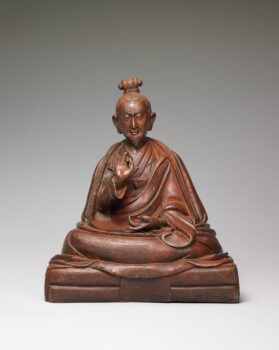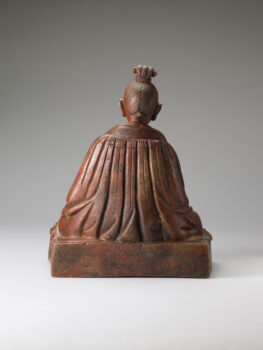Tibet
18th - 19th century
The hands form the shape of a wheel, symbolizing the “turning of the wheel of dharma,” a reference to teaching the Buddha’s doctrine.
Tibet
18th - 19th century


This portrait of the Buddhist master and scholar shows him dressed in a garment of a Tibetan lay person seated on a cushion with a slightly askew posture. His lined face is distinct, with big ears, a goatee, and hair in a top knot. These elements show him as a human rather than an idealized version of a teacher, suggesting that this sculpture might have been created during his lifetime or by someone who knew him. Jigme Lingpa is famous for his visionary experiences and writings that are important in the Ancient (Nyingma) and the Great Perfection (Dzogchen) Tibetan Buddhist traditions. He is considered a great “treasure revealer” ( terton). Treasure revealers articulate their personal relationships with the legendary Indian master Padmasambhava in their writings. Having a karmic connection allows them to tap into memories of past lives and, with the power of their devotion and practice, discover concealed teachings. In his autobiography Jigme Lingpa recalls receiving a vision in a dream. He experienced a visionary journey to the Bodhnath Stupa in Nepal, where a dakini, a tantric goddess, identified him as the reincarnation of King Tri Songdetsen (742–ca. 800) and entrusted him with a treasure-bearing casket. This discovery became the Heart Essence of the Great Expanse, one of the most influential treasure teachings practiced to this day.
Teachings and precepts that offer practical and experiential guidance. In Buddhism instruction is primarily an oral tradition and is often targeted to the specific needs or disposition of a student or disciple.
The passing down of authentic Buddhist teachings from a teacher to a disciple or student, often in the form of a text in a ritualistic context.
The transmission of teachings from one generation to the next, from teacher to student, traced all the way back to the Buddha without interruption. A complete lineage is essential in Tantric Buddhist practices as it makes the blessings of the teaching more powerful.
Himalayan art includes portraits of legendary and historical humans, including accomplished religious teachers (lamas), the Buddha’s original disciples (arhats), and spiritually accomplished tantric masters (mahasiddhas).
Today, Tibetans primarily inhabit the Tibetan Plateau, situated between the Himalayan mountain range and the Indian subcontinent to the west, Chinese cultural regions to the east, and Mongolian cultural regions to the northeast. During the 7th to 9th century, Tibetan rulers expanded their empire across Central Asia, and established Buddhism as the state religion.
Get the latest news and stories from the Rubin, plus occasional information on how to support our work.